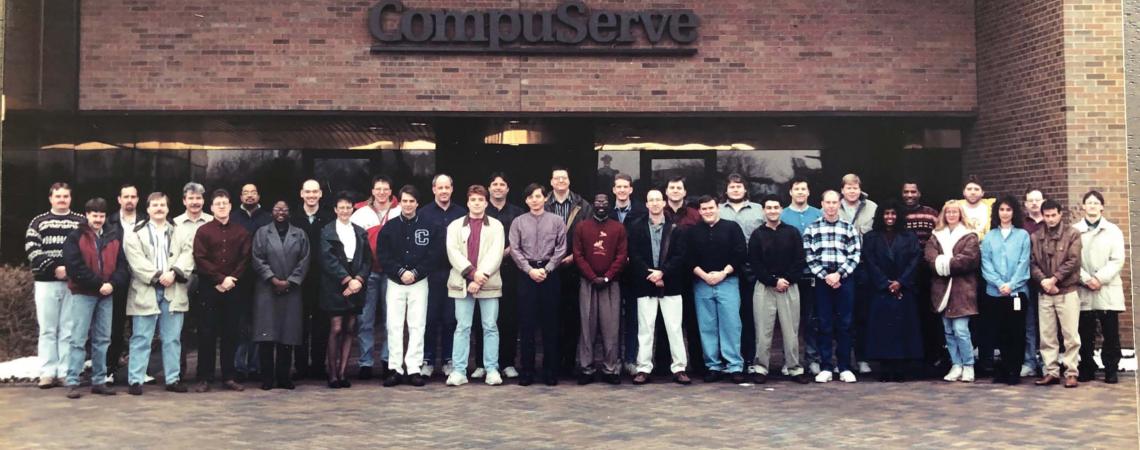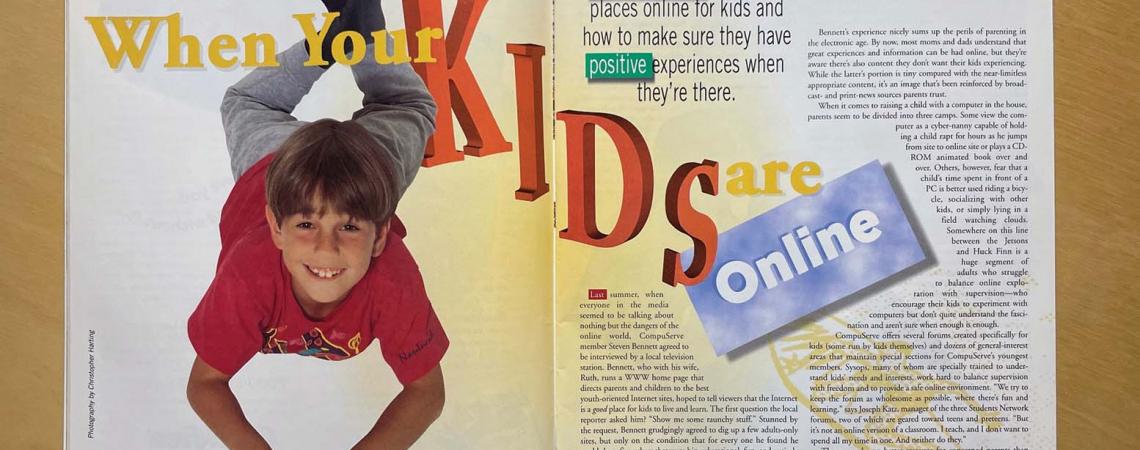
It’s a debate that’s been raging for more than 30 years — something that’s part of almost everyone’s lives, yet every day, people stumble over how to pronounce a three-letter word that describes a digital image: “GIF.” Does it have a hard “G,” like “gift,” or should it sound more like the peanut butter?
Ohioans have the home-court advantage in the debate. New Milford resident Steve Wilhite, in fact, is the computer engineer who developed the Graphics Interchange Format in the 1980s. In the decades since then, he’s used a classic TV ad to teach people how to say it: “Choosy developers choose GIF.”
The CompuServe team poses for a company photo outside its Columbus headquarters in 1996. At its peak, CompuServe had 135 employees.
Wilhite invented the GIF while he worked at CompuServe, an early tech company that was based in central Ohio. Although the name may not mean much to anyone under 40, CompuServe played a pivotal role in the early days of the Information Age. Digital breakthroughs still in use today originated there, including online shopping, stock research, and self-serve airline tickets.
Golden United Life Insurance founded CompuServe in 1969 as a computer time-sharing service. A decade later, as the personal computer began making its way into American homes, the company saw an opportunity to reach consumers. In 1979, CompuServe Information Service (CIS) was born. For a monthly fee, subscribers could access a world of news and information as fast as their 300-baud modems could deliver it (in comparison, today’s slowest DSL lines are roughly 200 times faster; broadband can transport data nearly 1,000,000 times faster).
At the time, both CIS and home computers were new, so something as simple as a mouse could cause confusion — does it work like a TV remote? A sewing pedal? Can you clean it in the dishwasher? — so CompuServe’s customer service team often focused on teaching members computer basics, like how to double-click or change a password. The monthly CompuServe Magazine offered pages of tips for getting the most from the service.
Cleveland native Bill Louden was on the original CIS team. His memories include brainstorming with bright, creative, and practical thinkers “throwing things at a whiteboard to see what would stick” in the new digital world. “The CompuServe times were very heady because you were trying things that had never been tried before,” Louden says. “For something like the CB Simulator, we borrowed a metaphor from another world.”
CB Simulator was the world’s first real-time chat service, named for the citizens’ band radio craze of the day. On a Friday, CompuServe employees wondered if the concept could translate to the digital space. By Monday, Sandy Trevor had developed a working prototype. Like its 3-D counterpart, CB Simulator offered 40 channels of conversation and soon became the coolest online place to be. Strangers who wouldn’t have otherwise met became lifelong friends, business partners, and even couples: George Stickles of Dallas and Debbie Fuhrman of Phoenix fell in love there and were the first couple to be married on the CB Simulator in 1983.
CompuServe is also the source of early digital shopping. Members could browse catalogs and purchase goods from Tiffany and Co., the Metropolitan Museum of Art, and Neiman Marcus. It was exciting, if a bit tricky. 1980s computers did not display photos of products, so all shopping happened by text (search YouTube for a video of the early CompuServe Electronic Mall — it’s well worth three minutes of your time.)
Forums, similar to today’s Facebook groups, became the heart of the information service. Each forum covered a topic, such as music, collecting, or gaming. Fans mourned the passing of Jerry Garcia in the RockNet forum. Veterans reunited in the Military forum. Joining a forum meant abiding by its rules of conduct, and trolls were swiftly warned to keep the conversation civil or face being banned.
CompuServe dominated cyberspace through the 1980s and 1990s, when it reached more than 3 million subscribers. But competition grew fierce, and America Online (AOL) soon became the digital darling. In a complex $1.3 billion deal, AOL bought CIS, and the CompuServe network went to WorldCom in 1998.
From the original network team to the company’s last survivors, CompuServe employees know they were part of a unique moment in internet history. They still stay in touch through a private Facebook group and occasional reunions. According to Louden, the 1980s were special, but the digital era is just getting started.
“Many of the visions we had then are reality today, but not all of them,” he says. “Some of those visions are still yet to come.”
Cutting edge
Among the CompuServe firsts:
- First consumer email service
- First real-time chat service
- Coining the term “email”
- First online newspaper (The Columbus Dispatch)
- First online shopping
- First global chat, featuring sci-fi author Arthur C. Clark
- First online news conference from the White House (Vice President Al Gore, 1994)
- First online multiplayer game (MegaWars)
- First rock star event with the Rolling Stones’ Mick Jagger
- First song available for download (Aerosmith’s “Head First”)











